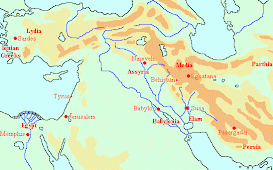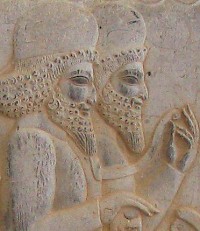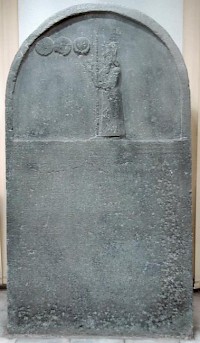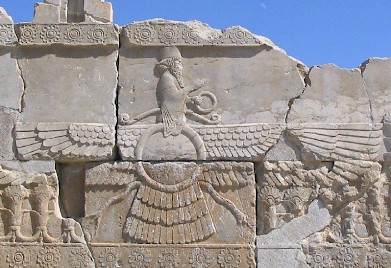Herodotus, bk 1, logos 2
Herodotus of Halicarnassus (c.480-c.429 BCE): Greek researcher, often called the world's first historian. In The Histories, he describes the expansion of the Achaemenid Empire under its kings Cyrus the Great, Cambyses, and Darius I the Great, culminating in Xerxes' expedition to Greece (480 BCE), which met with disaster in the naval engagement at Salamis and the battles at Plataea and Mycale. Herodotus' book also contains ethnographic descriptions of the peoples that the Persians have conquered, fairy tales, gossip, and legends.
The Rise of Cyrus (1.95-140)

The second logos of Herodotus' Histories deals with Cyrus' rise to power. Herodotus starts his story with a brief account of the origin of the Median Empire. The Medes (in the northwest of modern Iran) were the first to shake off the yoke of the Assyrians, who used to rule all Asia. Herodotus mentions several Median kings and states that king Cyaxares "captured Nineveh and subdued the Assyrians, all except the territory belonging to Babylonia".
Cyaxares' son Astyages is the next king of the Medes, and his daughter Mandane is married to a Persian named Cambyses, a 'man he knew to be of good family and quiet habits'. The Persians were subject to the Medes. A child is born: Cyrus. After some nightmares that predict the baby's future as lord of all Asia, Astyages decides to kill the child. Herodotus tells the fairy tale-like story of Cyrus' miraculous escape from danger; the boy grows up to become the bravest and most popular young man in Persia.
Then, he receives a letter from a Median courtier named Harpagus, who has a grudge against Astyages and wants to remove him. When Cyrus revolts, Astyages foolishly makes Harpagus the commander of an army against the rebels. Of course, the Median army defects to the Persians, and Astyages is imprisoned. From now on, Cyrus is the king of both Persia and the large Median empire. As we have seen in the first logos, he added Lydia a few years later.
This logos ends with a description of several interesting Persian customs. We learn a little bit about their religion, about alcoholic beverages, about the way they greet people, about their dislike of lies, et cetera.
Comment

Probably, the Medes were not a state (as Herodotus thinks) but a group of nomads, not really interested in urban life. The true cause of the fall of the Assyrian Empire is unknown, but the fact that Babylonia had gained independence in 626 must have been a very important contributing factor. According to cuneiform texts, the Babylonian king Nabopolassar and the Median leader Umakištar (Herodotus' Cyaxares) made an alliance in 614 BCE; even though Assyria obtained help from Egypt, the Babylonians and Medes destroyed the Assyrian capital Nineveh only two years later. (Go here for the cuneiform text.) The Assyrian cities were occupied by the Babylonians, who advanced along the Mediterranean shores to punish Egypt. The Medes were content to take the Assyrian treasuries to their homeland.
Cuneiform texts indicate that Cyrus (Kurush) was in fact (like his father Kambûjiya) the king of Persia, which was subject to Media.
After the elimination of Assyria, Babylonia had become a very powerful empire under its king Nebuchadnezzar, who had conquered Phoenician cities like Tyrus in the west and had advanced as far as Jerusalem (the Jewish elite was deported to Babylonia in 587). At the same time, the Medes had expanded their territories to the east to the Caspian Sea and to the north (where Cyaxares had fought an indecisive battle against Lydia in 585).

It was inevitable that these empires would clash, and it seems that the Babylonian king Nabonidus (or Nabû-na'id, ruled 556-539) has invited Media's Persian subjects to revolt. The Chronicle of Nabonidus informs us that in 550 'the army of Ishtumegu revolted against him and in fetters they delivered him to Kurush' (year six).
Since Herodotus is unaware of the diplomatic schemes of the last Babylonian king, we may assume that he was not using a Babylonian but a Persian source. This may be corroborated by the story of Mandane. On chronological grounds, it is extremely unlikely that Cyrus was the son of Cambyses and a daughter of Astyages. The idea that the new king of Asia was the son of an alliance between a Persian nobleman and a Median princess may have been part of the official Persian propaganda.

Some of the customs Herodotus mentions can be corroborated and he seems well informed. However, he does not always understand what he is describing. The Persian religion was founded by a legendary sage named Zarathustra, who had taught that there was a supreme god, the wise lord Ahuramazda, who was opposed by the forces of evil, which were under command of Angra Mainyu. (Since only Ahuramazda was to be venerated, the exiled Jews in Babylonia considered Cyrus a monotheist like themselves.) All other gods were regarded as mere good spirits or demons. The most remarkable aspects of this religion were the radical dualism and the presence of an ethical message: no other pagan religion had postulated a dichotomy between good and evil, light and dark, truth and lies. (Hence the Persian dislike of lies that Herodotus mentions.)
Herodotus seems not to understand this religion completely. Remarkable is his description of the ritual intoxication by drinking haoma that played an important role in the Persian religion. Herodotus thinks that the Persians, after making an important decision, drink too much wine, make up their drunken minds and know that their decision was sound when they still see things the same way when sober.
Before we conclude that Herodotus was totally ignorant: it is possible that he knew Zarathustra's theology very well, but hesitated to write it down. In his Egyptian logoi, he shows a sound knowledge of several sacred tales, but refuses to be explicit. See below.